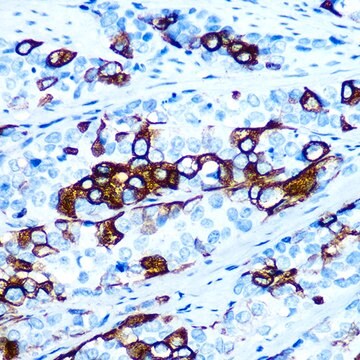03-102
RIPAb+ HuR - RIP Validated Antibody and Primer Set
from rabbit
Synonym(s):
ELAV-like protein 1, Hu-antigen R
About This Item
Recommended Products
biological source
rabbit
Quality Level
clone
polyclonal
species reactivity
mouse, human, rat
manufacturer/tradename
RIPAb+
Upstate®
technique(s)
RIP: suitable
immunocytochemistry: suitable
immunohistochemistry: suitable
immunoprecipitation (IP): suitable
western blot: suitable
NCBI accession no.
UniProt accession no.
shipped in
dry ice
Gene Information
human ... ELAVL1(1994)
General description
The RIPAb+ HuR set includes the HuR antibody, a negative control antibody (purified Rabbit IgG), and positive qPCR primers which amplify a 100 bp fragment of the human beta actin (ACTB) cDNA. The HuR and negative control antibodies are supplied in a scalable "per RIP" reaction size and can be used to functionally validate the precipitation HuR-associated RNAs.
Immunogen
Application
RIP lysate from MCF7 cells (2 X 106 cell equivalents per IP) was subjected to immunoprecipitation using 0.5 μg of either a normal rabbit IgG or Anti-HuR antibody. Precipitated proteins were resolved by electrophoresis, transferred to nitrocellulose and probed with anti-HuR (1.0 μg/mL).
Proteins were visualized using One-Step IP-Western kit (GenScript Cat. # L00231) (Please see figures).
Western Blot Analysis:
3T3/A31 lysate was resolved by electrophoresis, transferred to PVDF membranes and probed with HuR, hu (1:500 dilution). Proteins were visualized using a Donkey anti-Rabbit conjugated to HRP and visualized using a chemiluminescence detection system. (Please see figures).
Immunoprecipitation Analysis:
10 ug of this antibody immunoprecipitated HuR from 500 ug of 3T3/A31 RIPA lysate (Please see figures).
mmunocytochemistry Analysis:
Confocal IF analysis of HeLa, NIH/3T3 using anti-HuR (Red). Actin filaments have been labeled with AlexaFluor 488 -Phalloidin (Green). Nucleus is stained with DAPI (Blue) (Please see figures).
Quality
RIP Lysate prepared from HeLa cells (2 x 107 cell equivalents per IP) were subjected to immunoprecipitation using 5 µg of either a normal Rabbit IgG or Anti-HuR antibody and the Magna RIP Kit (Cat. # 17-700).
Successful immunoprecipitation of HuR-associated RNA was verified by qPCR using RIP Primers, ACTB (Please see figures).
Please refer to the Magna RIP® (Cat. # 17-700) or EZ-Magna RIP (Cat. # 17-701) protocol for experimental details.
Target description
Physical form
Normal Rabbit IgG. One vial containing 125 μg purified rabbit IgG in 125 μL storage buffer containing 0.1% sodium azide. Store at -20°C.
RIP Primers, ACTB. One vial containing 75 μL of 5 μM of each primer specific for human beta actin (ACTB). Store at -20°C.
FOR: TTG TTA CAG GAA GTC CCT TGC C
REV: ATG CTA TCA CCT CCC CTG TGT G
Analysis Note
Included negative control rabbit IgG antibody and control primers specific for human beta actin (ATCB).
Legal Information
Storage Class Code
12 - Non Combustible Liquids
Flash Point(F)
Not applicable
Flash Point(C)
Not applicable
Certificates of Analysis (COA)
Search for Certificates of Analysis (COA) by entering the products Lot/Batch Number. Lot and Batch Numbers can be found on a product’s label following the words ‘Lot’ or ‘Batch’.
Already Own This Product?
Find documentation for the products that you have recently purchased in the Document Library.
Our team of scientists has experience in all areas of research including Life Science, Material Science, Chemical Synthesis, Chromatography, Analytical and many others.
Contact Technical Service








